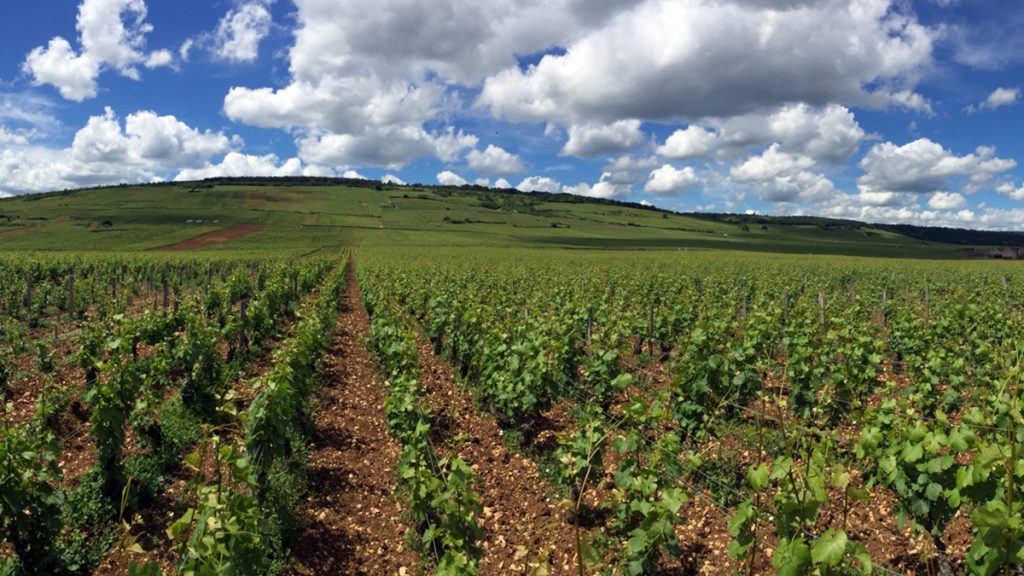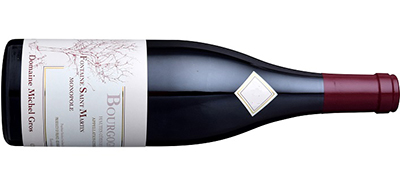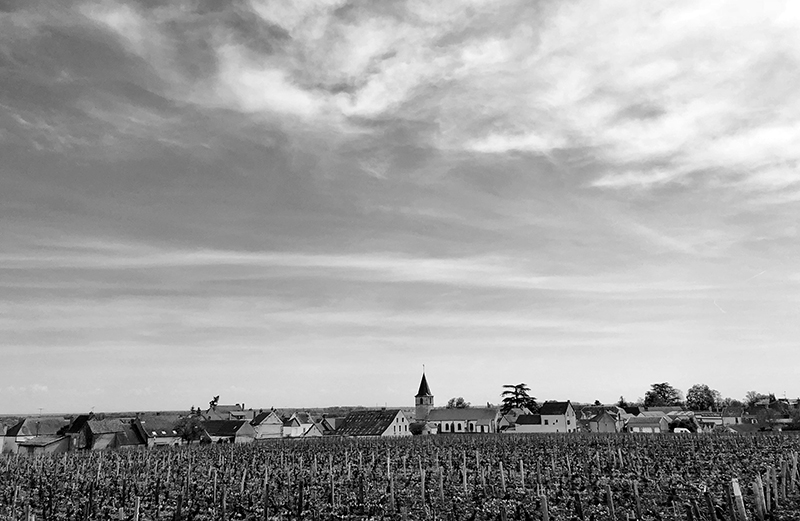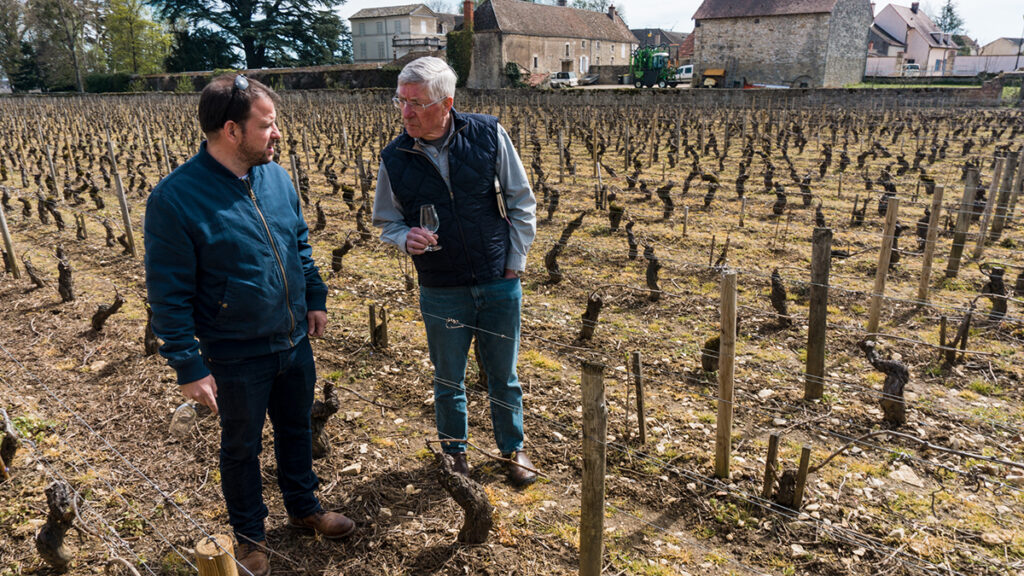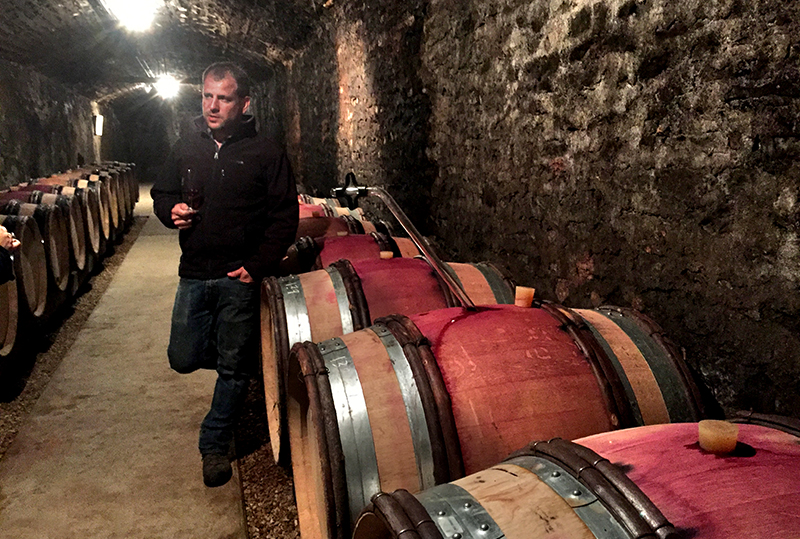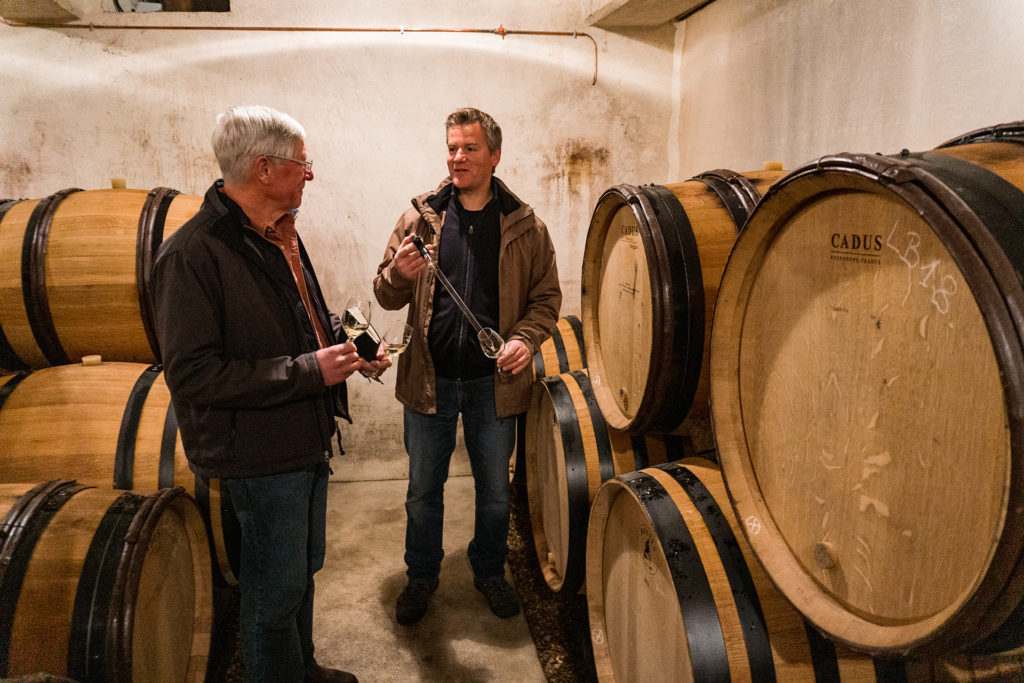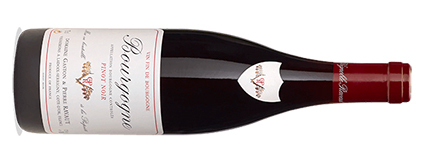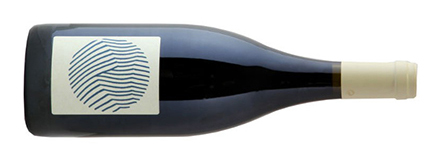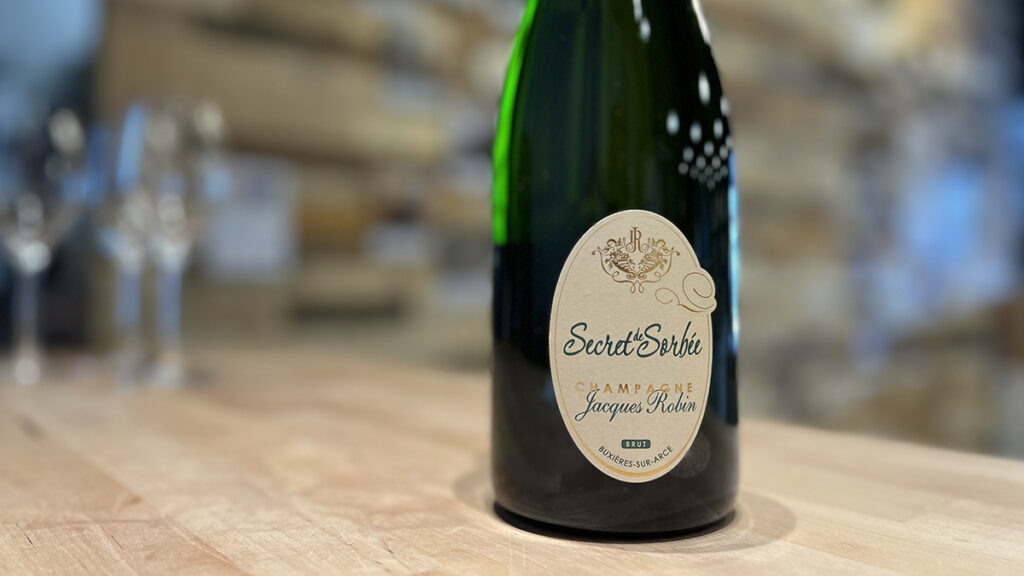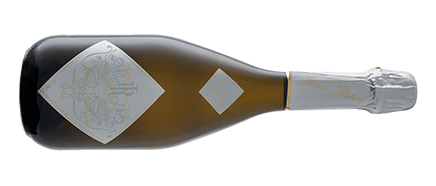November is an in-between time in the vineyards of France. The frenetic pace and the many judgment calls of the harvest are behind the vignerons, and the wines are steadily moving past primary fermentation into elevage. The year end holidays are not here yet. Those are something to behold in France, as the markets fill with special treats like five sorts of oysters instead of one or two; foraged mushrooms and “Trumpets of the Dead” alongside the Champignons de Paris; chestnuts ready for roasting on the hearth; and other seasonal delights. They really are quite something, and we still have fond memories of them from our sabbatical year in France more than two decades ago. November Futures begins with two of our most celebrated producers: The Domaine Michel Gros in the Côte de Nuits, and the Domaine Boyer-Martenot in the Côte de Beaune. We round out the Burgundy offer with wine from Maillet in the Maconnais, and from Ravaut, a producer below the slopes of the Hill of Corton. In the Loire Valley we return to Sanzay for exceptional value in reds from Cabernet Franc. We stop in the Côtes des Bar for Blanc de Noirs Champagne, and we canvas Bordeaux for more excellent values. Our goal is always to propose wines for every taste and budget, and we hope you’ll find something of interest here. If you do, please be sure to submit your orders, in case or half-case lots (and quarter-case lots for a few), by the Order Deadline of Sunday, November 19, 2023. We will place orders for the wine immediately thereafter. JUMP TO SECTION
Michel Gros
Boyer-Martenot
Ravaut
Maillet
Sanzay
Bordeaux
Robin
November Futures
Order Deadline: 11/19
Domaine Michel Gros
Vosne-Romanée, Burgundy
As most Burgundy lovers know by now, the 2021 growing season kept vignerons awake at night up and down the Côte d’Or. There was a long list of challenges: frost, hail, cold periods, wet periods, and all the various maladies that come along with them. In the Côte de Nuits the difficulties did not produce quite the catastrophic loss of quantity that they did for the Chardonnays of the Côte de Beaune (for which see the miniscule quantities of Vincent Boyer’s brilliant whites, detailed next). But for the Côte de Nuits 2021s, it very much matters who made your wine. When we visited this Spring we were pleased to find how well our producers did. As Allen Meadows (“Burghound”) put it, “2021 produced many really lovely wines that should provide for delicious drinking early on, yet be capable of amply rewarding mid-term cellaring. When the 2021s are good … they are a joy to drink.” Vintages like 2021 produce terroir-transparency, not so much big wines as focused ones that emphasize the uniqueness of their vineyards. Burghound was uniformly enthusiastic about the wines from the Domaine Michel Gros, and we agree with his assessments. Gros now has four bottlings at the regional level — one from the Côte d’Or itself, and three from the Hautes Côtes de Nuits, located just over the top of the Côte. Michel’s father was an early acquirer of vines in the Hautes Côtes, which feature soils very much like those of the Côte d’Or proper. The recent trend to warmer vintages has made ripening easier, and the wines of the Hautes-Côtes are getting more attention every year. As we reported in last Sunday’s opening post, the Bourgogne Côte d’Or is especially attractive in 2021, with a lovely aromatic profile of violets, cherries and earth. Unfortunately, too many of you agreed and it sold out. But we’re glad to be able to include Gros’s three regional wines from the Hautes Côtes in this offering. The vines in the Hautes Côtes generally produce darker fruit – more blackcurrant than cherries – and the Domaine’s three bottlings vary according to the particularities of their terroir. The regular Hautes Côtes cuvée offers blackcurrant fruit blended with plenty of earthiness and a hint of toasty oak. Right now, the minerals are front and center, and Burghound suggests perhaps a year in the cellar to round this wine out. Whether you take that route or simply give it some time in a carafe, it will make for a well-priced, refreshing blend of fruit and minerals particularly well-suited to the table. Hautes Côtes “Au Vallon” faces directly south and so ripens a bit more readily than the regular cuvée. The 2021 Vallon will require less patience than the regular bottling, offering both dark and red fruits along with notes of spice and violets. It’s a wine of medium weight with good precision that should drink well soon after it arrives. The Hautes Côtes “Fontaine St. Martin” 2021 is the most serious of three wines. The 2021 garnered Burghound’s “particularly outstanding for the appellation” marker, and has more density and greater length than the other bottlings. Neal Martin of Vinous agreed, finding “supple tannins, the oak neatly integrated, fine depth” concluding “this is very promising – deserves a couple years in bottle.” The mix of fruit, flowers and spice will benefit from some time in the cellar, but this wine will offer the most complexity in the long run of the three wines from the Hautes Côtes. At the Village level there are two wines from Nuits St. Georges; one from a group of vineyards near the border with Vosne-Romanée, and one from the “Chaliots” vineyard in the heart of the appellation, near “Les Saint Georges” that lends its name to the town. The former wine always shows a bit of Vosne spice along with its typical Nuits mix of cherry and blackcurrant fruit. The 2021 Nuits offers lovely aromatics in a higher register, providing a counterpoint to the base of earth, toast, and fruit. The 2021 Nuits St. Georges “Chaliots” is from the middle of the appellation, and as usual shows the meatiness that defines typical Nuits St. Georges. The beef-broth element adds depth and heartiness to the wine. It will be a good match for a mid-winter beef and root vegetable stew. The Domaine’s recent acquisition, Gevrey-Chambertin “La Platiere,” is very nice in 2021. Burghound praised its “lovely layering to the aromas of red currant, newly turned earth and hints of the sauvage and forest floor.” The attractive nose goes well with the wine’s density – this is Gevrey after all – and the combination suggests good aging potential over the next five years or so. Neal Martin of Vinous found it “harmonious, with a precise, mineral finish,” awarding 90-92 points and concluding “very fine.” Gros’s Morey St. Denis is from a vineyard at the top of the slope that adjoins three Grand Crus (Clos de Tart, Clos des Lambrays, and Bonnes Mares) from above. The elevation adds extra freshness to the complexity that comes from the fine terroir, but the wine from this vineyard always drinks well after a few years, showing excellent balance and an elegant mix of fruit and minerals. This is detailed, lace-like and precise, and in a terroir-transparent year like 2021, it is likely to be particularly nice. Chambolle-Musigny and Vosne-Romanée, the most sought-after villages of the Côte de Nuits, are both excellent in 2021. Half of the Chambolle cuvée is from a vineyard that adjoins the great Grand Cru “Le Musigny,” and the wine often develops at a pace more akin to a premier cru than a village wine. The 2021 has excellent potential, with a particularly attractive aromatic profile – lots of high notes, “aerien” as the French put it, and good underlying volume. The finish is long and a bit saline. Burghound thought the wine “sufficiently structured to repay up to a decade of cellaring.” The village Vosne-Romanée also promises a bright future. The expressive nose offers up a dose of the classic Vosne spice and violets, and the finish is long. As with all of the 2021 cuvées, Gros has extracted just enough tannin to support the fruit, and the resulting wine is lithe and middle-weight. We never have trouble finishing a bottle Vosne opened “too young,” but it will require serious restraint to keep your hands off the 2021s early. If you have the patience, this will provide an elegant accompaniment for refined dishes over many years. If not, no worries. As usual, the Gros wines show the very best at the high end. Burghound gave his “particularly outstanding” indicator to both the Vosne-Romanée premier crus in 2021: Aux Brûlées and the Clos des Réas, the town’s only premier cru monopole, which has been in the Gros family for more than 150 years. In Aux Brûlées 2021, Burghound offered particular praise for the “restrained but perfumed and even spicier nose [that] reflects notes of sandalwood, anise, exotic tea and pretty floral nuances.” The palate is dense, exhibiting “impressive power” according to Burghound, and the finish is very long. The story is the same for the Clos des Réas, which offers a similarly complex nose. Réas’s fame is as an elegant wine that drinks well early but also ages well, and we expect the 2021 to fit the pattern. Neal Martin effused “this might be one of the most nuanced and desirable Clos des Réas I have encountered…Bravo.” It will need a bit of time for its weight and depth to develop, but after just a year or so it should come into its own. We expect a classic Vosne here, with floral notes, spice and dark fruit, balanced by the note of toasty oak that is the Domaine’s signature. Finally, there is a very small allocation of Clos Vougeot from Gros’s very small parcel in the best section of this famous Grand Cru vineyard. Even in a year like 2021, his Clos Vougeot is big wine, very concentrated and powerful. The fruit is deep and dark, and the finish is extra long. As Burghound described it, “A classic Clos de Vougeot.” There’s precious little of this to go around, so we’ve lowered the minimum to 3 bottles. Gros usually serves his white last during our tastings, so we’ll do the same. The Hautes Côtes’ Fontaine St. Martin is also home to the Domaine’s sole white wine. Chardonnay is planted to about ⅖ of the monopole’s surface area, and so benefits from the same excellent soils as those found on the Hill of Corton. The wine, raised in oak barrels, has toasty notes of oak that recall the Domaine’s reds, together with orchard fruit dosed with a touch of lemon peel. The 2021 is of medium weight, with good length and balance. It is likely to drink well in the near term.
MICHEL GROS Hautes-Côtes de Nuits 2021: $365 Nuits-St-Georges 2021: $750 Vosne-Romanée 1er cru “Aux Brûlées” 2021: $1,995 Hautes-Côtes de Nuits “Fontaine-St-Martin” blanc 2021: $395
(case prices)
Hautes-Côtes de Nuits “Au Vallon” 2021: $385
Hautes-Côtes de Nuits “Fontaine-St-Martin” 2021: $395
Nuits-St-Georges “Chaliots” 2021: $795
Gevrey-Chambertin 2021: $850
Morey-St-Denis 2021: $895
Chambolle-Musigny 2021: $1,195
Vosne-Romanée 2021: $1,195
Vosne-Romanée 1er cru “Clos des Réas” 2021: $1,995
Clos de Vougeot Grand Cru 2021 (0.25 case min.): $2,995
Boyer-Martenot
Meursault, Burgundy
Though the challenges of 2021 were many for vignerons in the Côte de Nuits, they were even greater for the white wine producers of the Côte de Beaune. Chardonnay pushes its shoots earlier than Pinot Noir, and so the whites were even more susceptible to the Spring frosts that decimated the yields in 2021. Adding insult to injury, in the great white wine vineyards of Meursault, Puligny and Chassagne, the most frost damage occurred in the most celebrated premier crus, rather in the village and regional appellations. Nowhere did we see the impact of this more than in the cellars of superstar winemaker Vincent Boyer. Boyer’s quantities were down 80-90% across the board: where we are used to seeing a dozen or more barrels of Meursault Perrieres, we saw two last Spring. For the great Puligny 1er cru “En Cailleret” there was a single barrel, as there was for the Meursault 1er cru “Genevrieres.” Not that the loss of volume diminished the quality of the wines. Allen Meadows (“Burghound”) called the 2021 whites a “wonderful, and classically styled, old school vintage.” What is more, he bestowed his symbol for wines that are “particularly outstanding for their respective appellations and especially merit your attention” on every one of the Boyer-Martenot wines in our allocation. There is so little 2021 wine available from Boyer’s village and premier cru vineyards that we are making exceptions to our half-case futures minimum. (No one should count on getting much of any wine, however. We’ll likely have to sell them all in three bottle or smaller lots.) Notwithstanding the tiny quantities, for those with the budget and the patience, this vintage definitely belongs in the cellar. We mention the budget because prices are up (understandably – it’s awfully hard to run a business when 90% of your product evaporates in a single night) — and patience because these wines will need some time to round out and put on weight. They are intense and tightly wound, with great potential, but they will begin to show their best a few years down the road. Where you might have bought a case or half-case last year, your budget might only have room for a few bottles this year. Well, a few bottles is all we have, and we promise you won’t regret them. Before we get to all the scarcity and scarcity-driven prices, there’s a splash of good news chez Boyer: the regional vines were untouched by the spring frost, and Boyer’s Aligoté and Bourgogne are both terrific and abundant this year. First, there is his Aligoté 2021. Vincent Boyer is among the small group of vignerons who watched the region warming and recognized its potential to elevate the quality of Aligoté, Chardonnay’s poor relation. Les Aligoteurs, as they are known, have brought Aligoté light years beyond its skinny, acidic past. Vincent raises his Aligoté in older versions of the same barrels he uses for his famous wines from Meursault and Puligny, which gives the wine a roundness and weight that we wouldn’t have thought possible from this modest grape. Burghound praised the 2021’s “exceptionally fresh aromas includ[ing] those of lemon rind, green apple and spice,” and its “very fine persistence on the clean and agreeably dry finish.” Boyer-Martenot Aligoté has found a place in the cellars of many Ansonia Wines customers, and we suggest you try it if you haven’t already. If you prefer to stay with Chardonnay, consider Vincent’s excellent Bourgogne blanc. It can be had for about a third of the price of his village Burgundies, and yet showcases his first-rate winemaking skill. The Bourgogne 2021 is of medium weight, with an unusually long finish for its level. Like other 2021s, it is likely to put on some weight in the cellar as its energy softens and rounds out. The “white orchard fruit and orange peel scents” that Burghound identified should be there all along. The village-level wines share the character of the vintage, but will require a bit less patience than the premier crus. In Meursault, we have the usual yin and yang. Narvaux is far up the slope, at an elevation just above the great premier crus; and Ormeau is at the very base of the slope, with centenarian vines that settle into its deep clay soils, producing richer and rounder wines than those high on the slope. Many of our buyers cycle between them depending on the vintage, choosing the higher terroir in hot years and the lower one in cool or wet ones. But each vineyard offers its distinctive charm, and if you get a few bottles of each you can watch the different wines develop together. In Narvaux 21 Burghound found “restrained aromas of freshly cut lemon, lime, green apple and pretty floral wisps,” and praised its “outstanding density” and its “excellent length.” In Ormeau he found a “classic Meursault nose of hazelnut, white orchard fruit and acacia blossom” and “bigger and richer middleweight flavors.” Both wines reflect the character of the vintage, and while Ormeau will show its best before Narvaux, both will benefit from some time in the cellar, and neither will be a struggle to enjoy. (Note: both are available in 3-bottle lots.) Meursault’s three famous premier crus – Charmes, Genevrieres in and Perrieres – sit side by side just south of the town, and all three offer unique variations on the legendary terroir. Boyer has vines in all three, and while our allocation was reduced to six whole bottles this year for one of them, they are as outstanding as ever. We invite you to put in your requests, we’ll do our best, and then cast our eyes to the finally copious 2022s out next year. Both Meursault “Charmes” 1er cru and “Genevrieres 1er cru” will drink well sooner than Perrieres, though they share the precision and intensity of the vintage and will both put on weight and integrate with some time in the cellar. “Genevrieres” 2021 is its usual self, silky, suave and complex, with floral overtones at play alongside the fruit. Burghound found ”cool, elegant and airy aromas of zest, acacia and exotic tea,” and “gorgeously textured medium weight flavors.” He predicted a decade of aging potential. “Charmes” is always the most approachable of the three, and we think it will need some time as well. But we were impressed with its succulence and minerality. It shows a saline aspect that is rare from the vineyard. (Note: Charmes is available in 2-bottle lots; Genevrieres is available by the bottle.) Meursault 1er cru “Perrieres,” the vineyard most named as the next grand cru white, has huge intensity. Burghound awarded 92-94 points, praising its “first-rate freshness and verve,” its “laser-like focus,” and its “built to age finish.” His final thought: “This beauty is extremely promising, but patience absolutely required.” The only thing wrong with any of these is their quantity. (Note: Perrieres is available in 2-bottle lots.) Across the southern border in Puligny-Montrachet, Boyer has two cuvées: Reuchaux at the village level, and Cailleret at the premier cru level. Like Ormeau, Reuchaux is down on the flat near the RN-74. But a Puligny almost always needs a little more time than a comparable Meursault, so some patience will be valuable here as well. Burghound found a “floral suffused nose” with “aromas of white orchard fruit, citrus zest and exotic tea nuances.” It will drink well enough after maybe a year, and should be at its elegant best after a couple of years. (Note: Reuchaux is available in 2-bottle lots.) The Puligny-Montrachet 1er cru “En Cailleret” 2021 is about as well located as a premier cru can get. It adjoins Montrachet itself, in the same relative position as the other Grand Crus in the Montrachet complex. Burghound gave the 2021 the same score as Perrieres, offering similar comments, noting in particular its “highly sophisticated texture” and its exceptional length on the palate. He counsels patience here as well: “This stunning effort will also require moderately extended patience and ultimately should repay 12 to 15 years of keeping.” (Note: Cailleret is available by the bottle.)
BOYER-MARTENOT Aligoté 2021 (6 bot. min.): $24.58/bot Meursault 1er “Charmes” 2021 (2 bot. min.): $185/bot Puligny-Montrachet “Reuchaux’ 2021 (2 bot. min.): $125/bot
(NOTE: Bottle Prices)
Bourgogne blanc 2021 (6 bot. min.): $32.92/bot
Meursault “Ormeau” 2021 (2 bot. min.): $95/bot
Meursault “Narvaux” 2021 (2 bot. min.): $95/bot
Meursault 1er “Genevrières” 2021 (1 bot. min.): $185/bot
Meursault 1er “Perrières” 2021 (2 bot. min.): $195/bot
Puligny-Montrachet 1er “En Cailleret” 2021 (1 bot. min.): $295/bot
Domaine Ravaut
Ladoix, Burgundy
Like everyone else in Burgundy, the Ravaut family had a tough year in 2021. A cool, wet growing season made vignerons’ lives difficult from start to finish, and our quantities here are even smaller than usual. The wines remain excellent – clean, lightly-oaked, well-made wines of real value from underrated appellations. We always enjoy Ravaut’s premier cru Ladoix blanc – in fact it was the wine that led us to the domaine a decade ago. But during our barrel tastings this year it was unusually delicious. Vincent smiled and quickly solved the mystery for us: their Grand Cru Corton-Charlemagne plot was so devastated by frost that there wasn’t enough to make even a half-barrel’s worth… so it was blended into the premier cru. The resulting wine is as good as you’d expect: a beautiful, perfumed, exotic nose and a terrifically long mouthfeel packed with beautiful tension and light oak. This doesn’t quite reach Grand Cru depth, but it doesn’t carry Grand Cru pricing either. In reds, we have three perennial favorites to offer. First, Ravaut’s Bourgogne rouge, always among the best-value entry level wines we offer. The nose is gorgeous and deep with red fruits and hints of spice and earth. The mouth is lightweight and refreshing, a bit like 2017 in its accessible fruit and approachable tannin. This isn’t a serious wine, and probably one you won’t want to keep a decade in your cellar. But it delivers beautifully in the weeknight red Burgundy category. One step up in the appellation of Ladoix is the premier cru “Bois Roussot” vineyard. This shows Ravaut’s signature style – dark, briary fruits with a perfectly balanced note of wood. There’s often a savoriness to this cuvée, and this vintage delivers it in spades. There’s considerably more tannin in the mouth than the Bourgogne, but more than enough fruit to cover it appropriately. If classical red Burgundy is your thing – red fruits, a dose of delicate structure, excellent focus, and brisk freshness – this is a delicious, old-school example. Finally Ravaut’s Corton Grand Cru from Bressandes. As usual there’s not much of this to go around, but what’s there is top notch. It will require a few years for this wine to achieve the potential promised by its added cost, but once it does we expect great things. Jancis Robinson’s reviewer found it “refined, elegant, and long.” The vintage provided less concentration than the past few brutally hot years, and we think this will drink well a bit earlier than usual – think five years on from harvest rather than ten.
Nicolas Maillet
Verzé, Maconnais, Burgundy
The 2020 vintage was an unusual one in Burgundy – extreme heat and drought condensed the growing season, and most vignerons ended up with tiny crops of very ripe grapes. The 2020 red Burgundies are varied: those with enough acidity to balance the ripeness are delicious; others slip into overripeness and flabbiness. The 2020 whites, on the other hand, are almost universally terrific. The drought caused many chardonnay vines simply to shut down mid-season, stalling the production of their sugars and in the end producing wines with both a ripe concentration and tremendous energy. We bought just about all the 2020 white Burgundies we could get our hands on, and are pleased to offer what’s probably the last of the bunch today: Maillet’s Macon-Verzé 2020. Nicolas Maillet is a well-known organic source in the Maconnais, Burgundy’s southernmost region. Maillet is a bear of a man with a quick smile and burly enthusiasm to match his impressive stature. His wines are terrific, and still a bargain – William Kelley calls his Macon-Verzé “one of the Mâconnais’s perennial values.” His vines on chalk-limestone soils produce wines of beautiful tension, with classic lush Maconnais fruit, beautiful length and structure, and not a hint of wood. We love the charming golden character of this wine, a bit more tropical/exotic in its fruit profile than Giroux & Forces-Telluriques, but no less supple. William Kelley found notes of “green apple, honeysuckle and orange blossom,” calling it “ample and lively wine that’s pure and mouthwatering.” This is a perfect aperitif wine – a complete mouthful on its own. Serve it with anything and nothing; and with a price tag under $25, serve it any time at all.
Domaine des Sanzay
Saumur, Loire Valley
The Loire valley these days is producing a new kind of Cabernet Franc: nicely ripened dark cherry or blackcurrant fruit that is unburdened by the herbaceousness that seemed to plague Loire Cabernet Franc in the old days. Like the Beaujolais, the Loire is a hotbed of innovation, home to many younger winemakers applying organic and biodynamic principles to their craft. The Domaine des Sanzay is in the Saumur-Champigny appellation, and its wines are great representatives for the newer style. The Domaine des Sanzay’s 2022 Saumur Champigny is fresh and refreshing, a versatile wine to accompany simple meals of all sorts. It is a wine of little weight and no pretense, not heavily extracted and not for long keeping. Yet its plentiful, juicy ripe fruit offers a touch of sweetness in the nose, and there is excellent energy on the palate. The French say about such wines: “le premier verre appelle le deuxième,” or “the first glass calls for the second.” We love this Sanzay cuvée in warm weather when the grill is in constant use — at 13.5% the 2022 won’t add to the heat of the day — but there are plenty of meals with which to serve this wine throughout the year, say with a tomato-accented bouillabaisse, an omelet for lunch, or a home-made thin crust pizza. It’s a great resource when you need something more fun than serious, and at the price you can drink it early and often. If you want a wine with a bit more substance, consider the old vine cuvée from the 2021 vintage. It’s also nicely ripened Cabernet Franc dominated by its maraschino-cherry fruit, but there’s a bit more body and a bit more length. It spends some time in older oak barrels, which deliver some integration with little oak influence on the flavors. Sanzay’s Saumur-Champigny Vieilles Vignes 2021 is another versatile wine that will pair up well with all sorts of dishes, and this one will be nice for quaffing as an aperitif as well. The Domaine also offers some more serious, parcel-specific wines, with extended elevage in oak barrels. The Beauregard cuvée many of you will remember from the 2018 vintage. It comes from a small sand and clay parcel with 50 year old vines. The wine is much denser than the first two cuvées, with noticeable structure and mouth filling richness from the clay soils. It’s drinking well right now, but should also evolve gracefully over the next five years, perhaps more. As these wines age they become more Burgundian, adding sous-bois notes to the rugged red fruits. Beauregard is serious Cabernet Franc that’s worthy of patience and attention — don’t let the bargain pricing fool you.
Bordeaux
Haut Medoc | Pomerol
Unlike Burgundy, the wines of Bordeaux are distributed through a vast network of resellers – negociant houses with distribution agreements that can stretch back centuries. It can be a confusing place to do business, but also one that offers hidden gems – the sheer volume of wine available means that turning over rocks can result in real discoveries. Most days our inboxes contain half a dozen unsolicited sales pitches from the Bordelais by lunchtime, but each year we ask a handful of negociants we trust to send us samples. The result is an odd-ball rotating cast of mostly affordable Bordeaux you’ve likely never heard of. We have two in this issue, both from the 2016 vintage and nearing their 8th birthday: a delicious, perfectly mature Left Bank Cru Bourgeois, and a stellar Pomerol we think is a steal at the price. First, the Château de Malleret, a Cru Bourgeois from the Haut Médoc, has a terrific nose – deep and intense without a hint of evolution. Look for notes of blackberry, leather, and cocoa. The mouth shows slightly softened tannins (but with enough left to keep it clean-cut), excellent concentration, and a perfectly coated, surprisingly long finish. Neal Martin of Vinous, a notoriously tough grader, gave 91 points, finding an “intense bouquet” with “superb delineation” on the palate, concluding “this is definitely worth seeking out.” With a futures price tag in the $20s we think this is an outstanding bargain – serve it with steak this winter and your guests will guess you paid twice what you did. Over the river(s) in Pomerol, we’re excited to add Chateau Bel-Air to our lineup. The Chateau Bel-Air Pomerol 2016 is pure Merlot, and shows why the varietal and Pomerol’s clay-rich soils make one of the world’s great grape-terroir marriages. The nose is beautiful and deep with inky violets and plums in the nose – perfume and lush fruit abound. The mouth is deep and beautiful with the tension and cut so often lacking in “global merlot”. Antonio Galloni of Vinous gave 91 points, calling it “powerful, explosive Pomerol” with “plenty of immediacy and sheer appeal.” Drink this now from a decanter with a cassoulet or wintery stew, or age it another few years for a softened, velvety delight.
Jacques Robin
Côtes des Bar, Champagne
Having just offered Champagnes from Bardoux and Lancelot-Royer in our last two Futures Issues, we’ll complete the triad with Jacques Robin, our producer in the Côtes des Bar. This satellite region of Champagne in fact lies not far from Chablis, and its clay-rich soils are perfectly suited to pinot noir. Robin’s wines are pure pinot noir, and have become favorites among our readers due to their accessible pricing and mouthfilling textures. The clay gives the wines a broader mouthfeel than those from northern Champagne, and while these aren’t perhaps as refined as Bardoux (Montagne de Reims) and Lancelot (Côtes des Blancs), they’re friendly, gourmand, and delicious. Both wines on offer in this issue will be familiar. Secret de Sorbée is Robin’s pure Pinot Noir non-vintage Champagne, and majority of the current release is from the 2017 and 2018 vintages. It’s as beautiful as ever, and maybe more so. The nose is deep and delicious, with loads of depth and earthy richness. The barrel aging is apparent, resulting in toasty notes with the fruit. Look for raspberry jam alongside buttered toast and violets. The mouth is plush and palate-coating, showing plum, butter, and minerals. It’s a perfect aperitif wine, round and delicious on its own. Whenever we open this wine, we promptly run out. The 750s are $41.25, so at $8.25 a glass you won’t need much excuse to open one. We’re also pleased to offer the wine in magnum – it’s hard to think of a more festive sight than a double-bottle of Champagne, and the Secret de Sorbée mags don’t even break triple digits. Robin’s vintage cuvée is called Kimmerdigienne, a nod to the famous limestone in the local soil. We bought their 2011 for three consecutive years, and it was a revelation to anyone who tried it. The 2012 is a more than worthy successor, and from one of the top vintages in the last decade. The nose is a stunner, with notes of almonds, apricots, praline, and chalk. The mouth is delicious and complex, with notes of seashell, lemon zest, kiwi, brioche and vanilla. The 2012 has 6g dosage (vs 8 with the 2011), and is richer and bolder than last year’s – the mouthfeel is concentrated and chewy, and we think will impress just about anyone with a taste for bubbles.
ROBIN Champagne “Secret de Sorbée” NV: $495
(case prices)
Champagne “Secret de Sorbée” NV (6x 1.5L): $595
Champagne Kimmeridgienne 2012: $795
_____________________________ We expect these wines in December 2023 / January 2024. If you have any trouble submitting the new order form, you can always email us your order. Or give us a call with questions: 617-249-3657, or tom@ansoniawines.com The deadline to place orders for this issue is: SUNDAY, OCTOBER 19. Questions? Need advice? Call us: (617) 249-3657. OPTIONS FOR GETTING YOUR ORDERS Pick-up near Philadelphia. We’re pleased to restart our PA pickup option. Wines ordered for PA pickup will be available in January/February 2024, depending on temperatures. Email us for more details. Shipping elsewhere. In most states we can arrange for shipping at an additional cost that varies by location ($3.50 per bottle to the addresses west of Chicago; $2.50 per bottle east of Chicago). If shipping interests you, let us know the state and we will figure out if it can be done.
Pick-up in Massachusetts. We store our inventory at our new warehouse in Newton: 12 Hawthorn St, Newton MA 02458. Futures customers can pick up their orders here during Saturday open hours, or by appointment.
